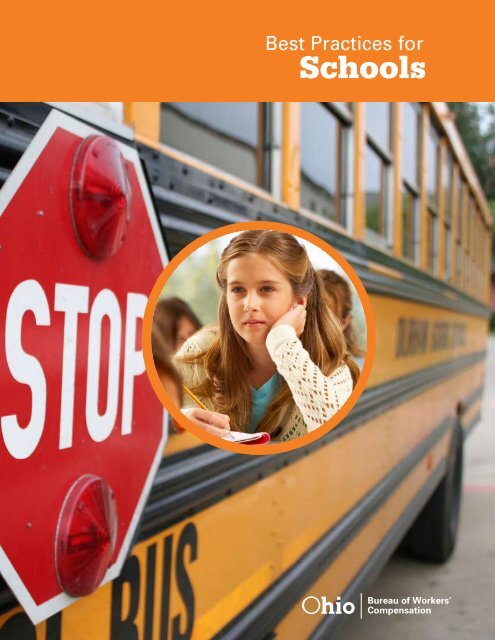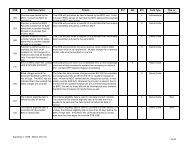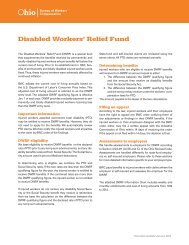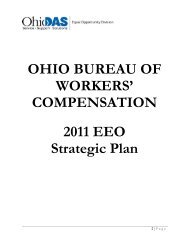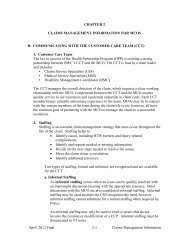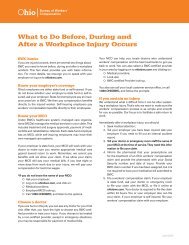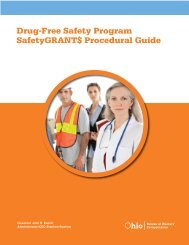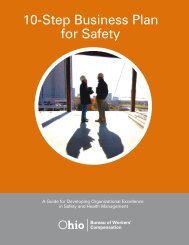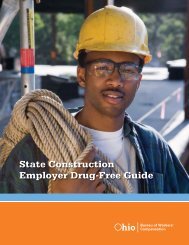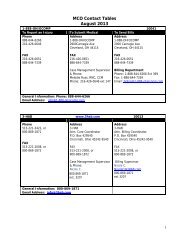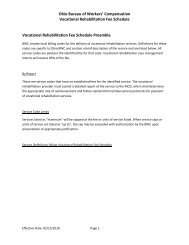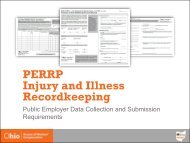Best Practices for Schools - Ohio Bureau of Workers' Compensation
Best Practices for Schools - Ohio Bureau of Workers' Compensation
Best Practices for Schools - Ohio Bureau of Workers' Compensation
Create successful ePaper yourself
Turn your PDF publications into a flip-book with our unique Google optimized e-Paper software.
<strong>Best</strong> <strong>Practices</strong> <strong>for</strong> <strong>Schools</strong><br />
<strong>Best</strong> <strong>Practices</strong> <strong>for</strong><br />
<strong>Schools</strong>
<strong>Best</strong> <strong>Practices</strong> <strong>for</strong> <strong>Schools</strong><br />
Contents<br />
Page No.<br />
Introduction........................................................................ 3<br />
Benefits <strong>of</strong> managing employee safety............................ 3<br />
Management commitment................................................ 4<br />
Employee involvement...................................................... 5<br />
Communication.................................................................. 5<br />
Safety education and training........................................... 6<br />
Injury reporting and treatment.......................................... 6<br />
Return to work/transitional work...................................... 8<br />
Safety audits and inspections........................................... 8<br />
Challenges.......................................................................... 9<br />
BWC’s safety services........................................................ 11<br />
Internet sites <strong>for</strong> school employee safety and health..... 11
<strong>Best</strong> <strong>Practices</strong> <strong>for</strong> <strong>Schools</strong><br />
Introduction<br />
This publication provides useful in<strong>for</strong>mation regarding strategies and practices employed<br />
by <strong>Ohio</strong> school districts in achieving successful employee safety and health, and workers’<br />
compensation management. You should not consider this publication a complete and<br />
exhaustive list <strong>of</strong> all possible employee safety- and health-management strategies. BWC’s<br />
Division <strong>of</strong> Safety & Hygiene obtained these best practice strategies through interviews<br />
with administrators <strong>of</strong> school districts throughout <strong>Ohio</strong>.<br />
We have grouped these strategies and practices into one <strong>of</strong> the following categories:<br />
• Management commitment;<br />
• Employee involvement;<br />
• Communication;<br />
• Education and training;<br />
• Injury reporting and treatment;<br />
• Return to work (transitional work practices);<br />
• Safety audits and inspections;<br />
• Safety programs.<br />
Also included in this publication are sections that highlight the following:<br />
• Challenges — What challenges and obstacles do these and other schools face when<br />
attempting to manage employee safety;<br />
• Solutions — What strategies may help overcome some <strong>of</strong> the challenges and obstacles;<br />
• Resources — Where to turn <strong>for</strong> in<strong>for</strong>mation and assistance.<br />
Benefits <strong>of</strong> managing employee safety<br />
On average, the schools that participated in our study achieved the following results:<br />
• A 14.8 percent increase in payroll;<br />
• A 34.6 percent reduction in premium;<br />
• A 78 percent reduction in claims;<br />
• One school district had zero claims in three out <strong>of</strong> the last five years;<br />
• One school district went from 45-percent penalty rated in to group rated (41-percent<br />
credit rated) by devoting a significant ef<strong>for</strong>t to its safety process. This school saw a<br />
54-percent reduction in premium. As a result, it paid approximately $151,000 less in<br />
premium. This same school district also experienced a 70-percent reduction in claims;<br />
• All school districts experienced reductions in injury frequency and severity;<br />
• Each school district credited the implementation <strong>of</strong> safety-related communication systems<br />
to improve overall communications throughout the districts. See the Communication<br />
section on page 5 <strong>for</strong> specific details;<br />
• All school districts reported heightened employee awareness <strong>of</strong> safety issues, both on<br />
and <strong>of</strong>f the job;<br />
• Several school administrators stated they believe the improvements in the employee safety<br />
and health process have had a positive impact on employee attitudes and morale.
<strong>Best</strong> <strong>Practices</strong> <strong>for</strong> <strong>Schools</strong><br />
Demographics<br />
• All <strong>of</strong> the schools included in this study were group rated with an average 42-percent<br />
credit rating. Group-rating status equates to significant reductions in workers’ compensation<br />
premium costs.<br />
• The schools have an average <strong>of</strong> 620 employees, ranging from 140 to more than 1,000<br />
employees.<br />
• On average, each school district operates 12 buildings.<br />
• Most schools are members <strong>of</strong> the <strong>Ohio</strong> School Boards Association (OSBA); although some<br />
are members <strong>of</strong> other associations, such as the <strong>Ohio</strong> <strong>Schools</strong> Council.<br />
• The person with chief responsibility <strong>for</strong> safety varied widely, but tended to be someone<br />
with the title <strong>of</strong> business manager, operations manager or facilities manager. These<br />
persons tended to be responsible <strong>for</strong> non-teaching staff, facilities and grounds.<br />
Management commitment<br />
• The key to success lies in the organization’s culture. What importance does top administration<br />
place on safety?<br />
• Commitment from the superintendent, treasurer and school board is critical.<br />
• Some school board members may be experienced business people with a solid understanding<br />
<strong>of</strong> employee safety and workers’ compensation. When available, take advantage<br />
<strong>of</strong> this experience.<br />
• All schools surveyed agree at least one key individual needs to be committed to safety<br />
and workers’ compensation.<br />
• Accountability is vital. Assign someone the responsibility <strong>for</strong> safety, provide him or her<br />
with the tools, training and authority to act, and then hold him or her accountable.<br />
• Once commitment to safety is in place with top administration, address safety responsibilities<br />
and accountability within each facility and across all departments.<br />
• Include employee safety measures in the per<strong>for</strong>mance-review process. Set safety goals,<br />
communicate expectations, establish per<strong>for</strong>mance measurements and hold people accountable.<br />
For example:<br />
1. Per<strong>for</strong>mance measures at the operational level (supervisors, teachers, counselors,<br />
custodians, food service employees, etc.) should focus on such activities as safety<br />
audits, safety meetings, in-service training, accident reports and safety suggestions;<br />
2. Per<strong>for</strong>mance measures at the school administration level (principal, assistant principal)<br />
tend to include tracking and measuring the safety activities at the operational<br />
level, as well as school-specific results, such as reduction in injuries, return to work<br />
and claims-management issues;<br />
3. Per<strong>for</strong>mance measures at the district administration level (superintendent, treasurer,<br />
business manager, school board) tend to include tracking and measuring school-specific<br />
results, and district-wide results, such as reduction in workers’ compensation<br />
costs and impact on total budget.<br />
• Consider developing and issuing a safety policy statement that clearly communicates<br />
top administration’s commitment to employee safety and health.<br />
• Historically, most schools have focused on student safety rather than employee safety. A<br />
comprehensive approach to safety can address both.<br />
“To have a good safety program, it must be integrated into the culture <strong>of</strong> the organization,”<br />
— Fred Stephens, director <strong>of</strong> business services, Lakewood City <strong>Schools</strong>
<strong>Best</strong> <strong>Practices</strong> <strong>for</strong> <strong>Schools</strong><br />
Employee involvement<br />
All school districts interviewed by the us stress the importance <strong>of</strong> employee involvement<br />
in the employee safety process. In addition, all <strong>of</strong> the school districts use some <strong>for</strong>m <strong>of</strong> a<br />
safety committee or safety team. Organization <strong>of</strong> teams and how they operate vary from<br />
school to school.<br />
One school district includes only classified employees on its team, while another school<br />
district includes teachers on its team. Perhaps the most effective team includes certified<br />
and classified employees, union presidents from both groups, principals, supervisors and a<br />
member <strong>of</strong> the school board.<br />
Effective teams have a well-defined purpose. They have good decision-making skills and<br />
the authority to act on their decisions. They consider meetings high priority and make all<br />
necessary accommodations to allow each member to attend. Effective teams emphasize<br />
shared decision making. They use input and feedback from the entire organization when<br />
possible. Involvement in safety activities is so important, these schools are willing to pay<br />
overtime, rearrange schedules or provide substitutes to allow employees to participate.<br />
The activities and responsibilities <strong>of</strong> each safety committee/team vary and include any<br />
number <strong>of</strong> the following:<br />
• Conduct regularly scheduled meetings;<br />
• Post meeting minutes in<strong>for</strong>ming the entire organization <strong>of</strong> the team’s activities and accomplishments;<br />
• Conduct safety inspections and/or oversee the inspection process;<br />
• Monitor the status <strong>of</strong> safety issues and hold people accountable <strong>for</strong> corrective action;<br />
• Monitor the safety-suggestion program, implement suggestions and provide feedback;<br />
• Publish a safety newsletter or contribute to the safety section <strong>of</strong> a general newsletter;<br />
• Form safety project teams as needed;<br />
• Constantly communicate safety issues to top administrators to keep them in<strong>for</strong>med,<br />
establish accountability and ensure timely completion <strong>of</strong> action items;<br />
• A school board member serves on the safety committee and acts as a liaison between<br />
the committee and the board;<br />
• An executive steering committee consisting <strong>of</strong> a school board member, the superintendent,<br />
the business manager, treasurer, principals and the safety team facilitator.<br />
“Safety starts at the top and must involve everyone in the organization,”<br />
— Fred Stephens, director <strong>of</strong> business services, Lakewood City <strong>Schools</strong><br />
Communication<br />
Extensive communication is a common theme among all school districts the we interviewed.<br />
However, there is no consistency in the way this communication takes place.<br />
Listed below are communication techniques used, some <strong>of</strong> which are outlined in the Employee<br />
involvement section on page 8.<br />
<br />
Communication techniques include:<br />
• Communicate the safety policy statement;<br />
• Communicate safety responsibilities, per<strong>for</strong>mance measures and accountability systems;<br />
• Post safety committee meeting minutes;<br />
• Hold safety meetings;<br />
• Operate a safety suggestion program and provide regular feedback and status reports;<br />
• Sponsor labor/management <strong>for</strong>ums;<br />
• Publish safety newsletters or a safety section in a general newsletter;
<strong>Best</strong> <strong>Practices</strong> <strong>for</strong> <strong>Schools</strong><br />
• Hold monthly/quarterly employee <strong>for</strong>ums with the superintendent;<br />
• Conduct one-on-one interaction on a daily basis. Attempt to address safety issues and<br />
concerns using the quickest methods and at the lowest level possible rather than waiting<br />
<strong>for</strong> the next committee meeting or <strong>for</strong>um. Communicate safety issues addressed at<br />
the local level. Communicate to the committee or the <strong>for</strong>ums so the entire organization<br />
can benefit from knowing what the safety issue was and how it was addressed;<br />
• One school district conducted a mini safety perception survey. A comprehensive perception<br />
survey is available through the Division <strong>of</strong> Safety & Hygiene. Contact your local<br />
customer service <strong>of</strong>fice <strong>for</strong> details.<br />
“Safety is a day-to-day thing. I try to take advantage <strong>of</strong> daily interactions with my employees,<br />
constantly stressing to them the importance <strong>of</strong> practicing safe work habits during<br />
their daily operations,” — Al Yano, service manager, Independence City <strong>Schools</strong><br />
Safety education and training<br />
All school districts interviewed by us stress the importance <strong>of</strong> safety education and training.<br />
Safety education and training begins with the top administration. Often, however, top<br />
administration does not fully understand workplace safety issues or the workers’ compensation<br />
system. As one school administrator put it, “You first have to educate the educators.”<br />
BWC employer services specialists are available to meet with you to discuss your workers’<br />
compensation history, analyze your practices and recommend improvements. And Division<br />
<strong>of</strong> Safety & Hygiene safety consultants are available to meet with you to analyze safety<br />
culture and practices, and recommend improvements. In addition, there is a multitude <strong>of</strong><br />
Division <strong>of</strong> Safety & Hygiene training courses available to help you better understand workers’<br />
compensation and safety-management strategies.<br />
Safety education and training <strong>for</strong> employees — principals, assistant principals, supervisors,<br />
teachers, counselors, custodians, food service employees, groundskeepers, etc. — are<br />
just as important. Here are things you can do to make your employee safety education and<br />
training effective:<br />
• Implement an effective new employee orientation process;<br />
• Conduct employee in-service training;<br />
• Provide job-specific training to all employees;<br />
• Take advantage <strong>of</strong> all training opportunities through your local education associations,<br />
third-party administrators (TPAs) or other sources;<br />
• Use the training seminars and videotapes available through the Division <strong>of</strong> Safety & Hygiene.<br />
Most schools conduct the bulk <strong>of</strong> their in-service training at the start <strong>of</strong> the school year.<br />
However, one district surveyed by us conducts training <strong>for</strong> classified employees in the<br />
summer months. Another district views training as so important that it appointed a training<br />
coordinator to oversee all training.<br />
Employees may perceive in-service training provided by an outside source as more credible<br />
and, there<strong>for</strong>e, have a greater impact.<br />
Injury reporting and treatment<br />
First, <strong>for</strong>malize the injury reporting and treatment process. Document it in writing. Then<br />
ensure it is well communicated and understood by all employees <strong>of</strong> the school district. And<br />
make sure injured employees report all injuries, no matter how minor, to their supervisor.
<strong>Best</strong> <strong>Practices</strong> <strong>for</strong> <strong>Schools</strong><br />
<br />
Consider specifying the time frame <strong>for</strong> reporting injuries in your policy (within 24 hours).<br />
Provide the necessary contact names and phone numbers to allow <strong>for</strong> this communication.<br />
Ensure the injured employee receives proper medical treatment. We recommend you take<br />
the following steps:<br />
• Establish a list (network) <strong>of</strong> preferred medical providers in your area;<br />
• Visit those providers and discuss treatment protocol and communication procedures;<br />
• Invite providers to tour your facilities to familiarize them with your operations;<br />
• Develop written job descriptions that include physical demands analysis and provide<br />
copies to the medical providers to assist them with return-to-work orders (see Return to<br />
work on page 9);<br />
• Clearly identify which party (school or medical provider) will complete BWC’s First Report<br />
<strong>of</strong> an Injury, Occupational Disease or Death (FROI) <strong>for</strong>m and submit it to the managed<br />
care organization (MCO).<br />
While your employee recovers from his or her injury, maintain close contact with the injured<br />
employee. Help him or her through the workers’ compensation process. Provide the injured<br />
worker with in<strong>for</strong>mation and answer his or her questions. Remind the injured worker<br />
<strong>of</strong> your interest to get him or her back to work as soon as possible. Hold the injured employee<br />
accountable to provide appropriate medical <strong>for</strong>ms and in<strong>for</strong>mation. And work closely<br />
with the injured employee, medical provider and the MCO to return the injured employee<br />
to work as soon as medically able.<br />
One school district we interviewed has its safety coordinator, in addition to its TPA, attend<br />
all Industrial Commission <strong>of</strong> <strong>Ohio</strong> hearings to clarify in<strong>for</strong>mation and answer questions<br />
related to each case.<br />
Following an accident, immediately conduct an accident analysis (investigation). Identify the<br />
person responsible <strong>for</strong> conducting accident analyses. This person may differ from district to district.<br />
Typically, the injured employee’s immediate supervisor, the safety coordinator, member(s)<br />
<strong>of</strong> the safety committee or a combination <strong>of</strong> these people, conduct accident analyses. Provide<br />
comprehensive training <strong>for</strong> all persons that will conduct accident analyses.<br />
Ensure the accident report <strong>for</strong>m includes accident causation analysis and corrective action.<br />
It is critical to learn how and why the accident occurred, and make the necessary changes<br />
to prevent recurrence <strong>of</strong> a similar accident. Also, consider having an accident-review team<br />
(can be safety committee) review all accidents <strong>for</strong> the following elements:<br />
• Accident reports are filled out completely and in a timely fashion;<br />
• Causal factor analysis completed with accident causes identified;<br />
• Corrective action specified, assigned and completed;<br />
• Coordinate communication between accident analysis process and workers’ compensation<br />
process. Often these functions are managed separately and yet to be effective,<br />
they must be closely coordinated;<br />
• Provide at least one well-equipped accident-analysis kit <strong>for</strong> each facility.<br />
Enter all recordable injuries on the appropriate recordkeeping log. Public schools should use<br />
the Public Employment Risk Reduction Program’s Form 300P. Private schools should use<br />
the Occupational Safety and Health Administration 300 Log. Analyze your injury/illness log<br />
to identify and address possible injury trends.<br />
Note: the Division <strong>of</strong> Safety & Hygiene <strong>of</strong>fers Accident Analysis training (train-the-trainer).<br />
Contact the training center <strong>for</strong> details.
<strong>Best</strong> <strong>Practices</strong> <strong>for</strong> <strong>Schools</strong><br />
Return to work/transitional work<br />
All schools interviewed confirm the importance <strong>of</strong> an effective return-to-work process. This<br />
is perhaps the single most effective claims-management strategy available. Most schools<br />
interviewed seem to handle return to work on an in<strong>for</strong>mal, case-by-case basis and have no<br />
<strong>for</strong>mal agreement with the union(s) or contract language on return to work. However, all<br />
schools work closely with their union(s) on all return-to-work cases.<br />
The study also found most school districts only return an injured employee to a job within<br />
the employee’s original job classification. However, a couple <strong>of</strong> school districts have negotiated<br />
return-to-work procedures into the union(s) contract(s). Some <strong>of</strong> these contractual<br />
agreements allow injured employees to return to any job that meets medical restrictions.<br />
Benefits <strong>of</strong> transitional work include:<br />
• The employee earns full wages, retains all benefits, earns service credits and continues<br />
as an active member <strong>of</strong> the union;<br />
• The school gets a productive worker, can take advantage <strong>of</strong> the injured employee’s experience,<br />
can use injured employees as trainers <strong>for</strong> substitutes or replacement workers,<br />
and saves workers’ compensation costs.<br />
Returning an injured worker to the job as soon as safely possible be<strong>for</strong>e the worker is 100-<br />
percent recovered lowers your workers’ compensation costs. It’s a guaranteed return on<br />
your human resources investment and your most valuable asset — your employees.<br />
A transitional work program uses real job duties <strong>for</strong> a specified time period to gradually return<br />
the injured worker to the workers’ original job. The program’s components include job<br />
analyses <strong>of</strong> the employee’s job tasks, labor-management collaboration, and program-policy<br />
development and program evaluation <strong>for</strong> effectiveness.<br />
Fact: National statistics show indirect costs <strong>for</strong> a work-place injury that becomes a lost-time<br />
claim is four times greater than any direct claim expense. These costs include decreased<br />
productivity, hiring and training replacement expenses, overtime <strong>for</strong> loss <strong>of</strong> work, legal bills<br />
and loss <strong>of</strong> morale, business and customer goodwill. The costs to your injured workers are<br />
even greater.<br />
For more in<strong>for</strong>mation on transitional work, contact your local BWC employer services specialist.<br />
In addition, you can access transitional work in<strong>for</strong>mation on BWC’s Web site at<br />
ohiobwc.com.<br />
Safety audits (inspections)<br />
Most schools we contacted indicate they conduct a comprehensive safety audit <strong>of</strong> each<br />
building at least annually as part <strong>of</strong> their safety process.<br />
If your school district doesn’t conduct regular safety audits, BWC safety consultants are<br />
available to assist you with developing and implementing a safety audit process.<br />
The primary purpose <strong>of</strong> a safety audit process is to identify and correct potential safety<br />
hazards be<strong>for</strong>e an injury occurs. Audits should focus on both unsafe conditions and unsafe<br />
behaviors.
<strong>Best</strong> <strong>Practices</strong> <strong>for</strong> <strong>Schools</strong><br />
The following are examples <strong>of</strong> safety audits that many schools have implemented:<br />
• Comprehensive safety audits (all facilities, annually or quarterly);<br />
• Custodian daily inspection check list;<br />
• Classroom and <strong>of</strong>fice self-audit check list;<br />
• Playground inspections (monthly);<br />
• Bus driver’s daily safety check list;<br />
• School bus monthly inspection and maintenance <strong>for</strong>m (bus mechanics);<br />
• School security check list (conducted after all alarm conditions);<br />
• Request <strong>for</strong> repair <strong>for</strong>ms (work orders).<br />
Ensure person(s) participating in an audit are thoroughly trained. Each audit process must<br />
have a review process associated with it. Review each audit report and identify action steps<br />
required to make necessary improvements. Assign responsibility <strong>for</strong> each action step, set<br />
target dates and hold people accountable <strong>for</strong> timely completion <strong>of</strong> action steps. Follow up<br />
to ensure the corrective actions were completed, they resolved the original safety issue<br />
and no new safety hazards were created.<br />
Safety programs (compliance)<br />
While conducting this study, it became apparent that most schools are not in compliance<br />
with House Bill 308, which created the public employer risk reduction program. One school<br />
used OSBA’s Safe Steps Program to enhance its safety process and address many compliance<br />
elements. Your local department <strong>of</strong> health may provide in<strong>for</strong>mation and assistance on<br />
some safety and health programs.<br />
In addition, many Division <strong>of</strong> Safety & Hygiene training courses will help you. Contact the<br />
training center <strong>for</strong> more in<strong>for</strong>mation.<br />
Challenges<br />
The school districts we studied clearly demonstrate they can effectively manage employee<br />
safety in schools and have experienced impressive results from their ef<strong>for</strong>ts. However,<br />
each <strong>of</strong> these school districts was quick to point out that managing employee safety in<br />
schools poses some significant challenges.<br />
Time<br />
• Finding the time to devote to safety, conduct training, hold meetings, and develop safety<br />
systems and processes seems to be the biggest barrier.<br />
• The challenge <strong>of</strong> coordinating schedules <strong>of</strong> the various employees involved in the safety<br />
process makes holding safety meetings difficult. Most schools state teachers are the<br />
most challenging group to involve in the safety process.<br />
• Few schools have or can justify having a full-time safety coordinator. There<strong>for</strong>e, safety<br />
responsibilities tend to be fragmented among several staff members who may not have<br />
the time to effectively manage the safety process.<br />
• There tends to be a public perception that most schools are top-heavy in administration.<br />
There<strong>for</strong>e, attempts to add administration to help manage safety can be difficult to sell.<br />
<br />
Funding<br />
• Most schools face constant battles to maintain and justify limited budgets.<br />
• Significant time and energy may be spent trying to convince the community to support<br />
a levy. This may reduce the time and energy available <strong>for</strong> safety activities.<br />
• As mentioned above, the budget does not permit adding staff to manage safety. There<strong>for</strong>e,<br />
safety responsibilities may fall to a person who has little time to devote to safety.<br />
• Most schools struggle with limited funding <strong>for</strong> facility maintenance and repairs. It becomes<br />
increasingly difficult to maintain aging buildings.
<strong>Best</strong> <strong>Practices</strong> <strong>for</strong> <strong>Schools</strong><br />
Competing priorities<br />
• Competing priorities and mandates pull schools in many directions.<br />
• Constantly changing priorities can create a trend where employee safety issues are<br />
addressed only during crisis or when convenient. <strong>Schools</strong> tend to deal with the most<br />
urgent priority today and then <strong>for</strong>get about it and move on to the next. This can seriously<br />
erode employee trust and confidence in the safety process.<br />
• Political issues and priorities do not always match with the desires and intentions <strong>of</strong> the<br />
school administration.<br />
• <strong>Schools</strong> will do what schools get measured and rewarded <strong>for</strong> doing. Top priority seems<br />
to be pr<strong>of</strong>iciency testing.<br />
• Historically, schools have concerned themselves primarily with student safety, not employee<br />
safety.<br />
Overcoming challenges<br />
The school districts that participated in this study have demonstrated an ability to overcome<br />
most <strong>of</strong> the challenges mentioned on the previous page. The following are recommendations<br />
to help school districts overcome the barriers to effective safety management.<br />
• Integrate employee safety into every operation <strong>of</strong> the school. It must be priority each<br />
and every day.<br />
• Use the many BWC services that are available to you at no additional charge. You pay <strong>for</strong><br />
these services through your premiums.<br />
• Educate school administrators about workers’ compensation and safety management.<br />
BWC can provide personal education on-site.<br />
• Include school board members in workers’ compensation and safety discussions. School<br />
board members are <strong>of</strong>ten business people with a clear understanding <strong>of</strong> workers’ compensation<br />
and safety issues.<br />
• Successful schools seem to have a very strong and dedicated person responsible <strong>for</strong><br />
safety. Identify who this individual is within your district. Ensure he or she has sufficient<br />
time to devote to the safety process.<br />
• Employee involvement (including teachers) is critical.<br />
• Gaining and maintaining trust is key. Employees must believe management is sincerely<br />
committed to employee safety. Management must earn employees’ trust daily by demonstrating<br />
its commitment to safety through actions.<br />
• Effectively managing employee safety results in significant reduction <strong>of</strong> operating costs.<br />
Money saved is available <strong>for</strong> use elsewhere in the budget. Examples may include:<br />
• Providing pr<strong>of</strong>essional development opportunities <strong>for</strong> staff;<br />
• Conducting safety-related in-service training;<br />
• Making needed facility improvements;<br />
• Purchasing new equipment, curriculum or technology upgrades;<br />
• Prolonging the budget to postpone the need <strong>for</strong> a levy or reducing the amount <strong>of</strong> the<br />
levy requested;<br />
• Funding extracurricular activities.<br />
• The final cost justification is the cost <strong>of</strong> doing nothing. Can you af<strong>for</strong>d to not manage<br />
employee safety and health?<br />
“To not manage employee safety and health would be irresponsible. If this was your<br />
money, what would you do?”<br />
— Betsy Franklin, coordinator <strong>of</strong> student processing services, Ashtabula Area City<br />
<strong>Schools</strong><br />
10
<strong>Best</strong> <strong>Practices</strong> <strong>for</strong> <strong>Schools</strong><br />
Final word<br />
Implementing an effective safety and health process will reduce injuries, keep experienced<br />
employees on the job, cut costs, improve morale and ultimately enhance the schools mission<br />
<strong>of</strong> educating students.<br />
BWC’s safety services<br />
To learn about the safety services BWC <strong>of</strong>fers, visit BWC’s Web site, ohiobwc.com, or call<br />
1-800-OHIOBWC to request a Safety Services Catalog.<br />
Internet sites <strong>for</strong> school<br />
employee safety and health<br />
Health in<strong>for</strong>mation network<br />
www.neahin.org/<br />
Indoor air quality<br />
www.epa.gov/iaq/school<br />
www.dehs.umn.edu/iaq/school<br />
www.ehhi.org/school<br />
School bus safety<br />
www.nhtsa.dot.gov<br />
School crime and violence issues<br />
www.fbi.gov/publications/school/school2.pdf<br />
www.schoolsafety.us<br />
www.ed.gov/about/<strong>of</strong>fices/list/osdfs<br />
www.nea.org/schoolsafety<br />
The National Council <strong>for</strong> Educational Support Personnel<br />
www.nea.org/esp/<br />
Site contains safety in<strong>for</strong>mation <strong>for</strong> bus drivers and custodial personnel.<br />
The National Clearinghouse <strong>for</strong> Educational Facilities<br />
www.edfacilities.org<br />
Hot topics on K-12 school planning, financing, design, construction, operations and maintenance.<br />
Recordkeeping<br />
www.ohiobwc.com/downloads/blankpdf/PERRPrecordkeepingpackaage.xls<br />
11


